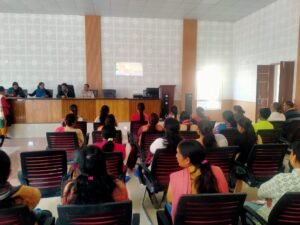Over the past five years, a remarkable transformation has been witnessed in the financial landscape of female members associated with self-help groups (SHGs) in India. According to an analysis conducted on March 11 by Soumya Kanti Ghosh, the Group Chief Economic Adviser at the State Bank of India, the incomes of these women have experienced a significant surge, more than tripling during this period.
From 2018-19 to the first nine months of 2023-24, female SHG members have seen their incomes escalate from a base of Rs 100 to an impressive Rs 307. This surge in earnings reflects not only an economic upliftment for these women but also signifies the effectiveness of SHGs in fostering financial inclusion and empowerment among marginalized communities.
Youth and Rural Participation in SHGs
 Going deeper into the demographic dynamics, Ghosh’s analysis unveils intriguing insights into the relationship between income growth and demographic factors among female SHG members.
Going deeper into the demographic dynamics, Ghosh’s analysis unveils intriguing insights into the relationship between income growth and demographic factors among female SHG members.
Particularly noteworthy is the substantial income jump observed among members aged below 27 years, reflecting a 4.7-fold increase in their earnings.
This demographic trend is further bolstered by a significant correlation between the rise in rural female labor force participation rate (LFPR) and the exponential growth in income among female SHG members.
Such findings underscore the pivotal role of SHGs in not only empowering women economically but also in fostering greater participation in the labor force, especially among rural youth, thereby driving inclusive economic growth.
Geographical Expansion and Government Initiatives
 The transformative impact of the SHG movement extends far beyond regional boundaries, with its footprint spreading across various states in India.
The transformative impact of the SHG movement extends far beyond regional boundaries, with its footprint spreading across various states in India.
Ghosh predicts a paradigm shift in the economic landscape by the fiscal year 2026-27, wherein most Indian states are expected to witness a substantial presence of “Lakhpati Didis” – SHG members earning annual household incomes exceeding Rs 1 lakh.
This vision aligns closely with the government’s ‘Lakhpati Didi’ program, aimed at bolstering economic empowerment and financial autonomy among women in rural areas.
By promoting entrepreneurship and fostering community resilience, such initiatives not only empower women economically but also contribute to broader socio-economic development, bridging the urban-rural divide and fostering inclusive growth.
Facilitating Economic Mobility
Amidst the income surge, the study highlights the evolving digital landscape within SHGs, with members increasingly embracing digital transactions. Analysis indicates a consistent pattern of expenditure via ATMs and a significant proportion of point-of-sale transactions occurring in metro regions.
Furthermore, SHG incomes transcend geographical boundaries, enabling members to wield purchasing power across districts and states. This newfound economic mobility, facilitated by SHG incomes, underscores the transformative potential of grassroots initiatives in driving inclusive economic growth and fostering socio-economic resilience at both local and regional levels.
By leveraging digital platforms, SHGs not only empower women economically but also facilitate their integration into formal financial systems, thereby unlocking opportunities for greater financial inclusion and prosperity.
In the evolving landscape of India’s socio-economic fabric, the surge in incomes among female members of self-help groups (SHGs) heralds a significant stride towards inclusive growth and empowerment.
Beyond the mere statistical uptick, this phenomenon embodies the transformative power of grassroots initiatives in uplifting marginalized communities and narrowing socio-economic disparities.
The journey from Rs 100 to Rs 307 in the span of five years symbolizes not just economic progress, but a profound shift in the lives of these women, affording them agency, dignity, and opportunities previously beyond reach.
 The success of SHGs in catalyzing this change is multifaceted. It underscores the efficacy of collective action, where women come together to pool resources, share knowledge, and support one another in pursuit of common goals.
The success of SHGs in catalyzing this change is multifaceted. It underscores the efficacy of collective action, where women come together to pool resources, share knowledge, and support one another in pursuit of common goals.
By providing platforms for skill development, entrepreneurship, and leadership, SHGs not only empower women economically but also equip them with the tools to navigate and thrive in an ever-changing world.
As India strides towards its vision of becoming a $5 trillion economy, the role of SHGs becomes even more pronounced. They serve not only as engines of economic growth but as beacons of hope, resilience, and inclusion in an increasingly complex and interconnected world.
By harnessing the collective potential of women, promoting gender-sensitive policies, and fostering an environment of collaboration and innovation, India can realize its aspirations of sustainable, equitable, and inclusive development.
The surge in incomes among female SHG members is not just a statistic, but a testament to the power of community, the resilience of the human spirit, and the promise of a brighter, more inclusive future for all.
ALSO READ: Swiss watches and chocolates to become more affordable for Indians










